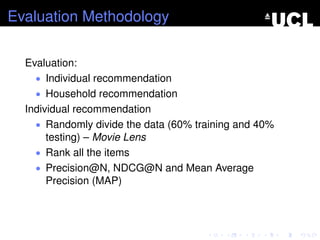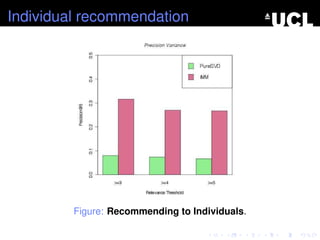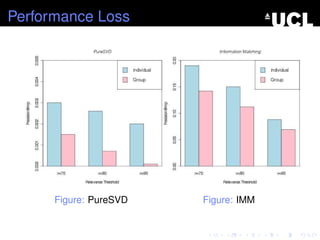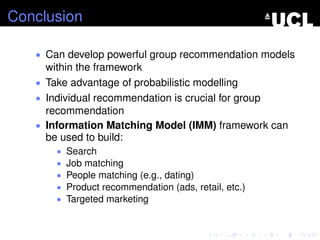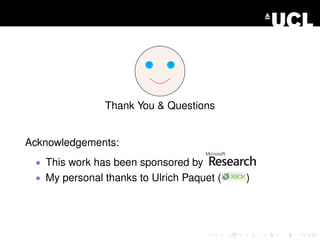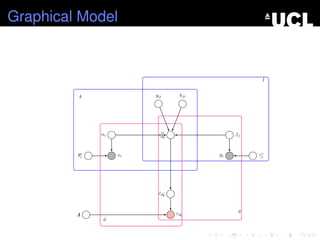Probabilistic Group Recommendation via Information Matching
- 1. Probabilistic Group Recommendation via Information Matching Jagadeesh Gorla (@jgorla)1 Neal Lathia (@neal lathia)2 Stephen Robertson3 Jun Wang (@seawan)1 1University College London 2 University of Cambridge 3 Microsoft Research Cambridge
- 2. What is the problem? ŌĆó Group recommendation ŌĆó How to compute Pr(group relevance | group, activity)? ŌĆó A probabilistic group recommendation model!
- 3. What is the problem? ŌĆó Group recommendation ŌĆó Individual users preferences? ŌĆó Type of the group (group preferences)?
- 4. Type of the groups ŌĆó Consensus preferences group ŌĆó Relevant to every group member
- 5. Type of the groups ŌĆó Shared preferences group ŌĆó Relevant to every group member, or at-least not disliked by majority of the group members
- 6. Type of the groups ŌĆó Split preferences group ŌĆó Relevant to at-least one group member ŌĆó e.g., Group of household members sharing the same TV but consume at different times
- 7. Individual vs. Group preferences ŌĆó Individual preferences
- 8. Individual vs. Group preferences ŌĆó Individual preferences
- 9. Individual vs. Group preferences What if they decide to watch a movie together?
- 10. Group recommendations? Merging individual preferences ŌĆó Merge and create group pro’¼üle ŌĆó Generate recommendations for group
- 11. Group recommendations? Merging individual preferences ŌĆó Merge and create group pro’¼üle ŌĆó Generate recommendations for group Problem: May present unwanted items, e.g.,Spartacus
- 12. Group recommendations? Merging individual preferences ŌĆó Merge and create group pro’¼üle ŌĆó Generate recommendations for group Problem: May present unwanted items, e.g.,Spartacus Merging individual recommendations ŌĆó Compute a list of recommendations for each member ŌĆó Merge the individual lists
- 13. Group recommendations? Merging individual preferences ŌĆó Merge and create group pro’¼üle ŌĆó Generate recommendations for group Problem: May present unwanted items, e.g.,Spartacus Merging individual recommendations ŌĆó Compute a list of recommendations for each member ŌĆó Merge the individual lists Problem: May lose preferences as part of a group
- 14. Group recommendations? Individual preference in a group may vary
- 15. Group recommendations? Individual preference in a group may vary Group recommendation should consider, ŌĆó Individual preferences ŌĆó Group preferences
- 16. Group recommendations? Individual preference in a group may vary Group recommendation should consider, ŌĆó Individual preferences ŌĆó Group preferences Hypothesis, ŌĆó Group relevance is a function of ŌĆ£individual group member preferencesŌĆØ
- 17. Probabilistic model Some notation: 1 G is a set of users ({u1, u2 ┬Ę ┬Ę ┬Ę , uh}) 2 Rg = 1 if the item is relevant to the group, and 0 otherwise 3 is a binary vector of individual relevance
- 18. Probabilistic model ŌĆó Group relevance P(Rg = 1|G, i) ŌłØRg h j=1 P(Rj, uj, i|Rg = 1) ├Ś h j=1 P(Rj|uj, i)
- 19. Probabilistic model ŌĆó Group relevance P(Rg = 1|G, i) ŌłØRg h j=1 P(Rj, uj, i|Rg = 1) ├Ś h j=1 P(Rj|uj, i) ŌĆó Individual relevance
- 20. Probabilistic model ŌĆó Group relevance P(Rg = 1|G, i) ŌłØRg h j=1 P(Rj, uj, i|Rg = 1) ├Ś h j=1 P(Rj|uj, i) ŌĆó Individual relevance
- 21. Probabilistic model ŌĆó Group relevance P(Rg = 1|G, i) ŌłØRg h j=1 P(Rj, uj, i|Rg = 1) ├Ś h j=1 P(Rj|uj, i) ŌĆó Individual relevance ŌĆó Least misery strategy: P(Rg = 1|G, i) ŌłØRg min{P(R1 = 1|u1, i), ┬Ę ┬Ę ┬Ę , P(Rh = 1|uh, i)}
- 22. Relevance to an individual Name: Jane Smith Sex: Female Age: 27 Location: Ipanema Product: Shoe Type: Formal Brand: Chanel Colour: Red
- 23. Relevance to an individual Name: Jane Smith Sex: Female Age: 27 Location: Ipanema Product: Shoe Type: Formal Brand: Chanel Colour: Red How to compute the relevance between Jane (ŌĆ£girl from IpanemaŌĆØ) & Shoe?
- 24. Relevance to an individual Traditional approaches: ŌĆó Neighbourhood approaches
- 25. Relevance to an individual Traditional approaches: ŌĆó Neighbourhood approaches ŌĆó Assume common feature space ŌĆó matrix factorisation (e.g., PureSVD)
- 26. Relevance to an individual Traditional approaches: ŌĆó Neighbourhood approaches ŌĆó Assume common feature space ŌĆó matrix factorisation (e.g., PureSVD) ŌĆó Model features as a user/item
- 27. Relevance to an individual We want a framework with: ŌĆó No explicit similarity
- 28. Relevance to an individual We want a framework with: ŌĆó No explicit similarity ŌĆó No common feature space
- 29. Relevance to an individual We want a framework with: ŌĆó No explicit similarity ŌĆó No common feature space ŌĆó Interpretable features
- 30. Relevance to an individual We want a framework with: ŌĆó No explicit similarity ŌĆó No common feature space ŌĆó Interpretable features Information Matching Model (IMM) or Bi-directional Uni’¼üed Model
- 31. Idea ... ŌĆó Find a best match for Me
- 32. Idea ... ŌĆó Find a best match for Me ŌĆó man ŌłÆŌłÆŌłÆŌłÆŌåÆ woman man preferences
- 33. Idea ... ŌĆó Find a best match for Me ŌĆó man ŌłÆŌłÆŌłÆŌłÆŌåÆ woman man preferences + man ŌåÉŌłÆŌłÆŌłÆŌłÆwoman woman preferences
- 34. IMM U/Q/P ╬▒3 ╬▒2 ╬▒4 ╬▒1 . . . ╬▒l ╬▓3 ╬▓2 ╬▓4 ╬▓1 . . . ╬▓k Pro/D/P/Ad
- 35. IMM U/Q/P ╬▒3 ╬▒2 ╬▒4 ╬▒1 . . . ╬▒l ╬▓3 ╬▓2 ╬▓4 ╬▓1 . . . ╬▓k Pro/D/P/Ad
- 36. IMM U/Q/P ╬▒3 ╬▒2 ╬▒4 ╬▒1 . . . ╬▒l ╬▓3 ╬▓2 ╬▓4 ╬▓1 . . . ╬▓k Pro/D/P/Ad
- 37. IMM U1 U2 . . . ╬▒3 ╬▒2 ╬▒4 ╬▒1 . . . ╬▒l ╬▓3 ╬▓2 ╬▓4 ╬▓1 . . . ╬▓k Pr1 Pr2 . . .
- 38. It solves the problem of ŌĆ£Uni’¼üed Model for Information RetrievalŌĆØ S.E. Robertson, M.E. Maron and W.S. Cooper, The uni’¼üed probabilistic model for IR, 1982.
- 39. Data Dataset Users Movies Ratings scale MovieLens1 1K 1.7K 100K [1-5] MovieLens2 6K 4K 1M [1-5] MoviePilot (Tr) 171K 24K 4.4M [0-100] MoviePilot (Eva) 594 811 4,482 [0-100] Number of households: 290
- 40. Evaluation Methodology Evaluation: ŌĆó Individual recommendation ŌĆó Household recommendation Individual recommendation ŌĆó Randomly divide the data (60% training and 40% testing) ŌĆō Movie Lens ŌĆó Rank all the items ŌĆó Precision@N, NDCG@N and Mean Average Precision (MAP)
- 41. Individual recommendation Figure: Recommending to Individuals.
- 42. Performance Loss Figure: PureSVD Figure: IMM
- 43. Conclusion ŌĆó Can develop powerful group recommendation models within the framework ŌĆó Take advantage of probabilistic modelling ŌĆó Individual recommendation is crucial for group recommendation ŌĆó Information Matching Model (IMM) framework can be used to build: ŌĆó Search ŌĆó Job matching ŌĆó People matching (e.g., dating) ŌĆó Product recommendation (ads, retail, etc.) ŌĆó Targeted marketing
- 44. Thank You & Questions Acknowledgements: ŌĆó This work has been sponsored by ŌĆó My personal thanks to Ulrich Paquet ( )
- 45. Graphical Model ╬▒i zij dq ╬▓j ╦årdq rdq xi yj J ╬Ėv i ╬│v j gij hji l k d q

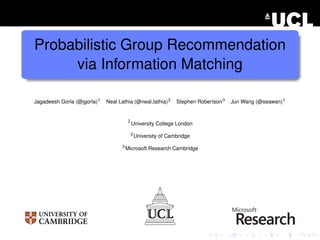
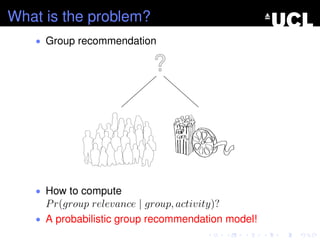
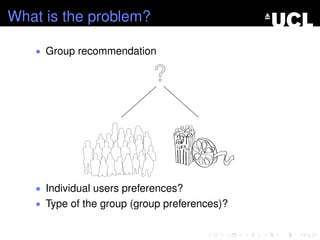
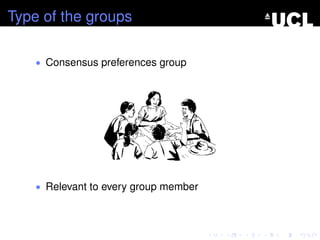
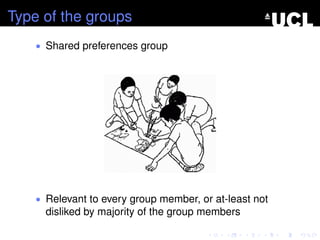
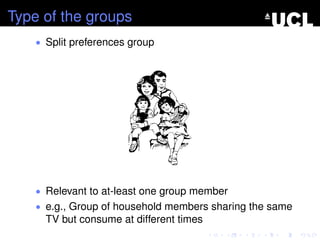
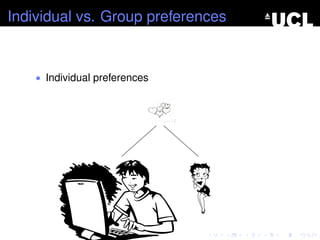
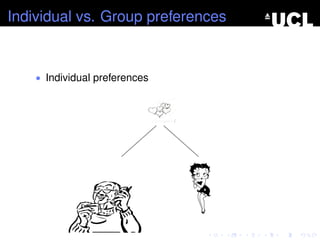
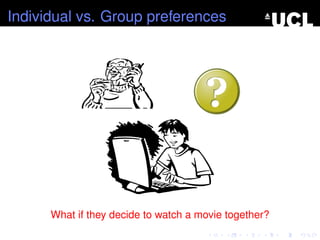
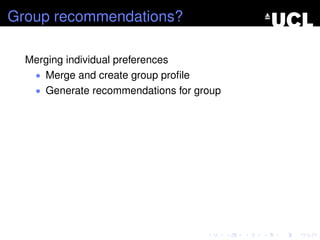
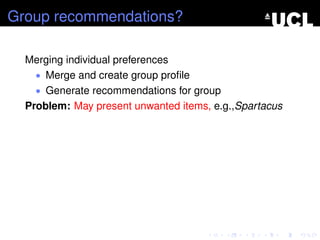
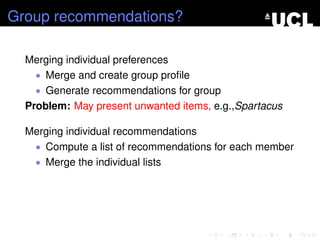
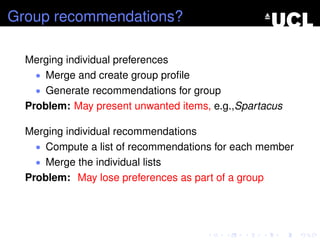
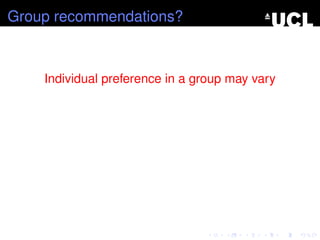
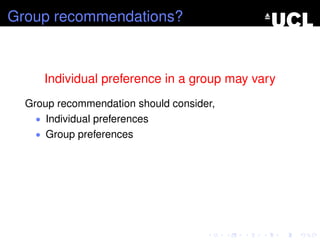
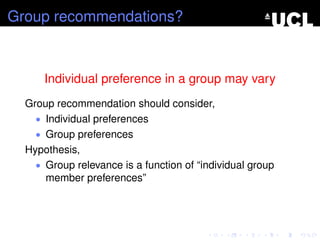

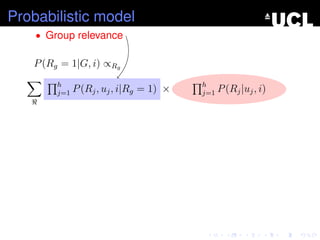
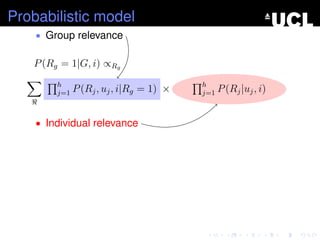
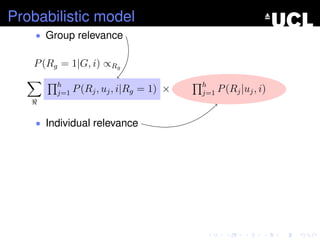
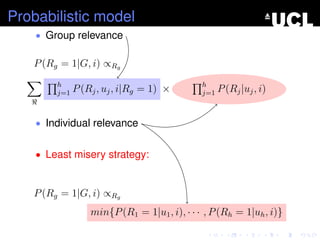
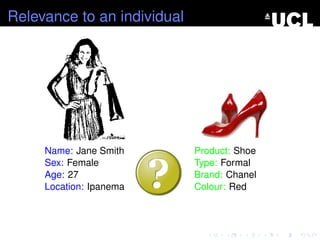
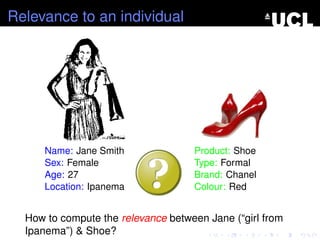

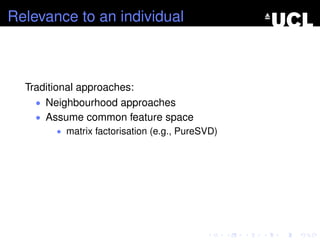
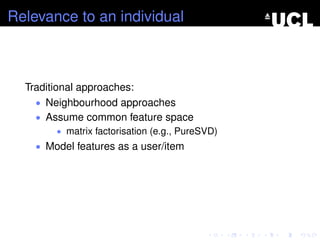
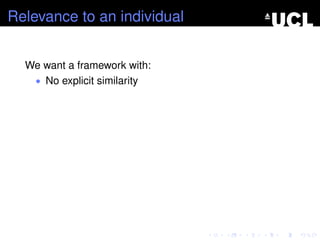
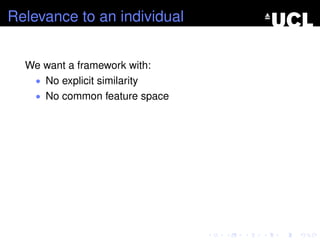
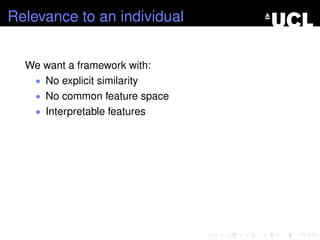
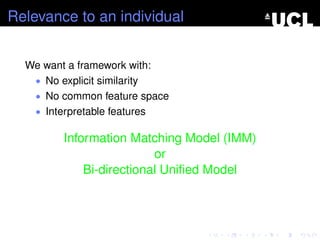

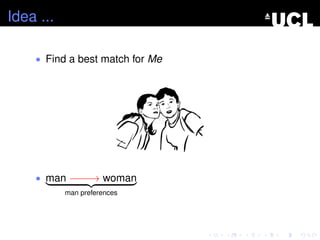
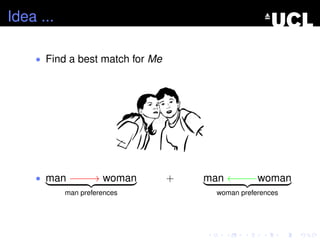
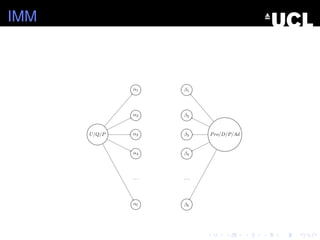
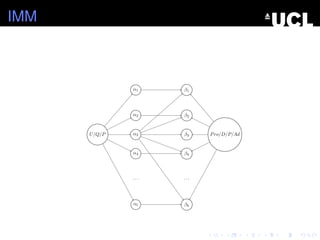
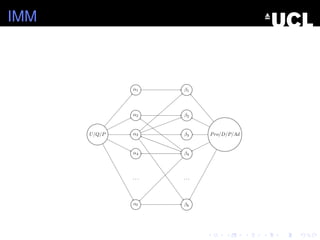
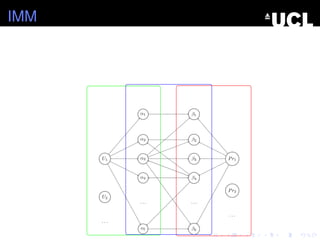
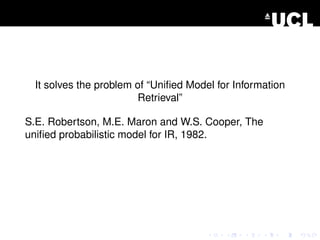
![Data
Dataset Users Movies Ratings scale
MovieLens1 1K 1.7K 100K [1-5]
MovieLens2 6K 4K 1M [1-5]
MoviePilot (Tr) 171K 24K 4.4M [0-100]
MoviePilot (Eva) 594 811 4,482 [0-100]
Number of households: 290](https://image.slidesharecdn.com/www-gorla-grouprecsys-130518062414-phpapp01/85/Probabilistic-Group-Recommendation-via-Information-Matching-39-320.jpg)
